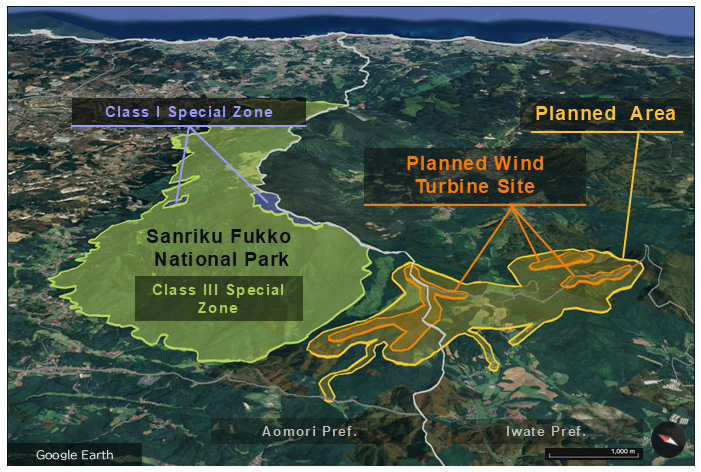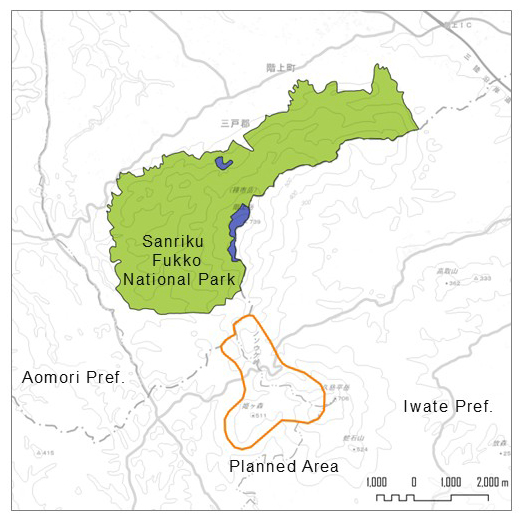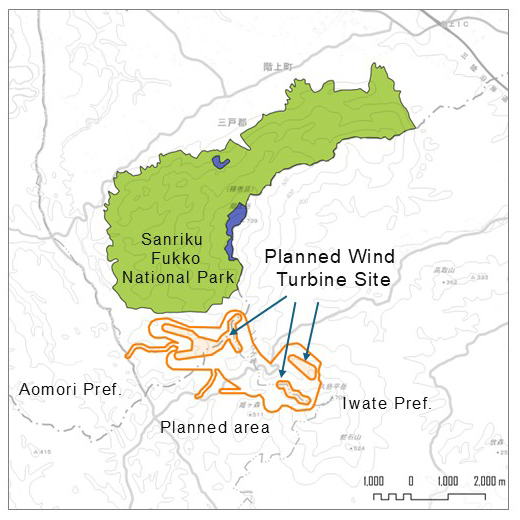A Dormant Plan Revived After 10 Years: Statement Submitted Calling for a Fundamental Review
2025.5.20

- The Nature Conservation Society of Japan submitted a statement on the Environmental Assessment methodology for the “Nosouke Pass Wind Power Project (tentative)" (Developer: ENEOS Renewable Energy Co., Ltd.
- The project, which was originally suspended for 10 years after the publication of an environmental consideration document in 2015 (prior to the environmental impact assessment) has now been revived.
- Despite receiving critical feedback from the Ministry of the Environment urging a review of the plan at the time, the project is now proposed to be expanded both in scale and scope. Concerns are rising over its potential impact on the natural environment, particularly on the nearby Sanriku Fukko National Park and other surrounding ecosystems.
The Nature Conservation Society of Japan (NACS-J) (Chairman: TSUCHIYA Toshiyuki) has submitted a statement on the environmental impact assessment methodology (prepared by Asia Air Survey Co., Ltd.) for the "Nosouke Pass Wind Power Project (tentative)", which is planned in Hachinohe City and Hirakawa Town in Aomori Prefecture, and Karumai Town and Hirono Town in Iwate Prefecture.
This project was on hold for approximately 10 years. Proposals that have been suspended for prolonged amounts of time are difficult to judge if they have appropriately made environmental considerations, especially when factoring in the changes in society and the natural environment that may have occurred during the time on hold. Furthermore, despite the current goal of a nature-positive society, this project contradicts the biodiversity policy of ENEOS Holdings, the parent company of the project developer ENEOS Renewable Energy Co., Ltd. There are significant issues with the plan itself, and a fundamental review, including potentially halting the project, is required.
Read the statement here (Japanese only)
Key Points of the Statement
The main points of the statement are as follows:
1. Ten years have passed since release of the environmental consideration document — the Environmental Assessment process should be restarted
The environmental consideration document for this project was issued in August 2015, after which it was suspended for nearly ten years. The Central Environment Council of the Ministry of Environment has pointed out that such projects which have been on hold for prolonged periods of time often fail to sufficiently reflect changes in social conditions and the natural environment that have occurred, potentially undermining proper environmental consideration*. Additionally, from a community consensus building standpoint, continuing with such a long-suspended project is inappropriate and therefore the current assessment procedure should be withdrawn.
*Central Environment Council, Recommendations on the Future of the Environmental Impact Assessment System and Second Recommendation on Environmental Impact Assessment for Wind Power Projects (March 2025)
The issue of suspended projects:
Nationwide, there are currently 26 projects for which the EIA process has been suspended for over 10 years, and 96 projects for which it has been suspended for over 5 years. If a project such as this proceeds by merely fulfilling the EIA process as a formality and without appropriately considering societal and environmental changes, it risks setting a precedent. This could open Pandora's box for other long-suspended projects.
2. The plan contradicts ENEOS’ biodiversity conservation efforts
ENEOS Holdings, the parent company of this project, considers biodiversity conservation an important mission and has conducted thorough biodiversity risk assessments. However, this plan is located in proximity to the Sanriku Fukko National Park and hence poses a risk to the biodiversity and ecosystem networks in and around the park. As such, this plan goes against the basic principles and guidelines of ENEOS7 biodiversity conservation policies.
3. The project plan was expanded despite receiving strong criticism from the Minister of the Environment
This project received strong recommendations for major revisions from the Minister of the Environment ten years ago, when the environmental consideration document was published. Nevertheless, both the scale and scope of the plan have since been expanded. In other words, rather than reflecting the Minister’s comments, the project plans to increase its negative environmental impact.
 Planned Area in Primary Environmental Impact Consideration (2015)
Planned Area in Primary Environmental Impact Consideration (2015)
 Planned Area in Method Statement
Planned Area in Method Statement
National Park Boundaries, National Survey of the Natural Environment of Japan (Ministry of the Environment) and Pale Color Map (Geospatial Information Authority of Japan).
4. Procedures should follow the Aomori Prefecture Ordinance on the Coexistence of Nature, Local Communities, and Renewable Energy
In the initial stages of the project proposal in 2015, this project was planned entirely within Iwate Prefecture. However, the current plan has expanded to also include areas of Aomori Prefecture. This area falls within a designated conservation zone under the ordinance scheduled to come into force in July 2025. Given that this area was not originally included when the environmental assessment procedures began, steps should now be taken in accordance with the provisions of this new ordinance.
Reference
About the Nature Conservation Society of Japan (NACS-J)
Founded in 1951, the Nature Conservation Society of Japan (NACS-J) is one of the oldest nature conservation organizations in Japan, dedicated to protecting nature and biodiversity.
NACS-J’s activities began with the conservation of Oze’s natural environment during a dam construction project and later contributed to the World Natural Heritage registrations of Yakushima, Ogasawara, and Shirakami-Sanchi.
Today, the organization continues to protect vulnerable natural environments across Japan with the mission, “Making A New Path For Tomorrow, With The Power of Nature.”
NACS-J envisions a society where people and nature coexist harmoniously, enabling people of all generations, from infants to the elderly, to live happily surrounded by nature.
The organization conducts nationwide surveys, conservation projects, and other initiatives to make use of natural resources, spanning from mountains to the ocean.
Latest List
2025.6.13
Human Depopulation May Lead to Biodiversity Loss
Findings from a Big Data Analysis of 158 Satoyama and Rural Areas Across Japan
2025.5.21
Collaboration with Panasonic!
Purchasing a Panasonic hair dryer can contribute to plastic reduction and nature conservation!
2024.12.24